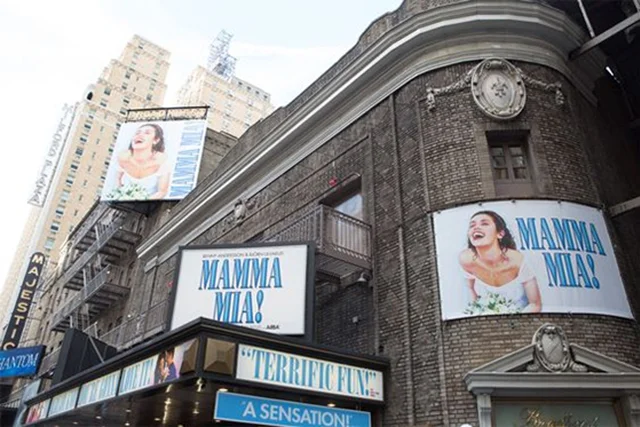MAMMA MIA! Show History
AROUND THE WORLD
Mark Shenton looks at the global explosion of MAMMA MIA!, which has fanned out from London’s West End to embrace Broadway and the world.
It was on March 23, 1999 that the musical MAMMA MIA! met its first and most crucial test when it was put in front of its first-ever paying audience in London – and was given the kind of welcome it has been getting ever since, every night, at every one of the many productions that have since followed. But that early spring evening in London, it was still a completely unknown quantity. “We really had no idea how it was going to be received,” reflects the producer Judy Craymer whose initial concept, exactly a decade earlier, it had been to use existing ABBA songs within the format of a new, original musical. But happily, she remembers, “The audience went wild. They were literally out of their seats and singing and dancing in the aisles – and they still are. Every night.”
And now, they are doing so all around the world. It has become a global entertainment phenomenon, which has now been seen by over 60 million people worldwide, in over 440 major cities. It has set the record for premiering in more cities worldwide faster than any other musical in history, from Toronto to Broadway, and from Australia to its first foreign language production in Germany (where it would eventually become the first major musical to play concurrently in three Germany cities) to going home to ABBA ’s original Stockholm home in a Swedish-language production in 2005.
It has set records wherever it has gone: in Moscow, for instance, it became the city’s best selling musical ever and the first show to play seven shows a week, setting the record for the most number of performances in a straight run within the shortest period of time in Russia. A production that opened in Shanghai in 2011 marked the first time a first-class production of a Western musical has been produced in Chinese; following its run there, it toured throughout China. In New York, having celebrated over 12 years and 5000 performances at the Winter Garden Theatre, MAMMA MIA! transferred to the Broadhurst Theatre on Broadway in 2013. At its final performance in September 2015, MAMMA MIA! was the 8th longest running show in Broadway history. As for the original flagship production, it continues to delight audiences at the Novello Theatre, where it opened in September 2012 following record-breaking runs at the Prince Edward Theatre and Prince of Wales Theatre. The London production has now played over 7,000 performances and seen by over 8 million people.



But wherever it plays, its creators have never lost sight of what they were seeking to achieve, and it helps to explain how and why it has achieved such a remarkable resonance and relevance. That was the process of personalising a familiar repertoire of particular ABBA songs in a fresh, vital and immediate way that simultaneously retained their pop integrity yet also did something more that is an essential requirement of good musical theatre: to advance an appealing story and comment on it.
But though in this case the songs came first – and it was Craymer’s genius to spot their theatrical potential so early on – she also had to find a way of unlocking that potential, with a story strong enough to carry them. “I knew from the outset that MAMMA MIA! had to be much more than just an ABBA compilation or tribute show,” she comments. “The story had to be as infectious as the music and provide a strong feel-good factor.” That, however, is easier said than done, and thus began Craymer’s decade-long crusade to find it and bring it to the stage.
The producer, who had been in on the ground floor (or at any rate the backstage door) of another West End musical phenomenon when she was a stage manager on the original London production of Cats in 1981, had subsequently joined Tim Rice’s production company, and it was there, while working as Executive Producer on the West End production of his and Benny Andersson and Björn Ulvaeus’ first post-ABBA project Chess, that she was first bowled over by Benny and Björn.
For Björn, meanwhile, it was his experience on the subsequent ill-fated Broadway production of Chess that taught him an important lesson. “What I understand after Chess is that story is No 1, No 2 and No 3, as they say on Broadway. A lyric should take a story forward, and a lot of pop songs are static – they have no drama in them whatsoever.”
The playwright Catherine Johnson, who was commissioned to write the book for MAMMA MIA!, fortunately found plenty of drama in them; and indeed, a plot out of them. Not only are they frequently complete stories within themselves, but she also discovered something else important: that many of the early ABBA songs were more innocent, naive and teenage-orientated, whereas later on they became more mature and reflective. And, of course, it was women who sang them. So that suggested a story about two generations of women, namely a mother and a daughter.
Ulvaeus, while insisting that lyrics weren’t arbitrarily changed, for his part also demanded, “the story is more important than the song”, but for Johnson, the challenge was that, “whatever happens in the story, I always have to come back to the song.” She was intent on avoiding the perennial fault of musicals: “We didn’t want to have those awful clunky moments where people burst into song. I am primarily a dramatist. To me it was very important that I create believable characters and gave them all a true story line, and I absolutely worked to get the story and the songs to work together.”
It then fell to Craymer to find the ship’s captain of any musical: a director. Though Phyllida Lloyd had never directed a musical before, Craymer instinctively felt she would be right for the project – and Lloyd, whose own background was in plays and opera, accepted the challenge, knowing that “if she stuck to what she knew – how to help actors create characters and stories – things would be okay”. Grounding the project as a good director does, it was able to take flight.
Though it was accident rather than design, Craymer notes, “I am delighted that MAMMA MIA!’s success was the result of an unprecedented collaboration of three women, but there was no discrimination of men intended.” And in fact, the onstage relationships of the three best friends – Donna and the Dynamos – at the centre of the piece mirrors that of the women who between them created the show: Craymer has indeed commented, “We all see ourselves as those three women on the stage, because Catherine is the slightly chaotic single mom, I’m the high-maintenance one, and the pragmatic one is Phyllida.”



The secret of the show’s success, however, is that it’s not just its creators who see themselves onstage, but the audiences do, too. Phyllida Lloyd notes, “In Catherine Johnson’s ingenious story, the audience seemed to be having a very particular experience. They were seeing themselves on stage.” In the process, the songs are re-born and the show’s themes – of lost parents, a search for identity, and the generation gap – have a universal resonance. As Johnson says, “There’s a mother-daughter relationship; an old romance; there’s losing someone and finding them again. There are all kinds of things that everyone can relate to.” This is a show about real people in real situations, yet a wonderful pop score that provided the soundtrack for a generation in the ’70s and early ’80s anchors it now as the soundtrack for a show whose appeal crosses all age and national boundaries.
The essence of that is conveyed, too, in MAMMA MIA!’s distinctive logo: an image of timeless wedding day happiness that instantly conveys emotions of joy, even elation, just as the show itself does. Like the show it represents, that picture has become an internationally recognised brand in cities around the world as the image of MAMMA MIA!.
The show also happily reconciles the worlds of pop music and musical theatre that were once indivisible: indeed, in the ’30s and ’40s, the popular music of the day came from the world of musicals, whether of the Broadway or Hollywood variety, but as pop music gained its own ascendancy in the ’50s and into the ’60s, musical theatre was left behind to go its own, variously sophisticated ways. MAMMA MIA! is a sophisticated, but not pretentious, musical that re-introduces the familiarity of a pop idiom – with songs that people already know and love – to the theatre.
And once MAMMA MIA! became a beloved part of the musical theatre landscape, it was time for it to challenge another medium and find yet another whole new audience: in the cinema. With producer Judy Craymer, writer Catherine Johnson and director Phyllida Lloyd all reprising their original roles from the theatre in bringing it to the big screen with Universal Pictures, the film had its worldwide premiere in London on June 30 2008 – and made history all over again as the highest grossing movie of all time at the UK and Irish film box office, and the highest grossing musical film worldwide.
The numbers speak for themselves, but it is the numbers in the show – those glorious, instantly memorable ABBA songs – and the way they are fused so effortlessly into the story, that makes it work again. Supplemented in the film by the beautiful location shooting, a cast that includes Meryl Streep, Pierce Brosnan, Colin Firth, Stellan Skarsgard, Christine Baranski and Julie Walters make them pulse with new life.
Everywhere – from theatres and movie theatres to screenings at home – MAMMA MIA! is, to paraphrase another ABBA song, making audiences grateful for the musical. “Who can live without it, I ask in all honesty/ What would life be?/ Without a song or a dance what are we?” MAMMA MIA! provides a thrilling example of how enhanced life can be with it.
